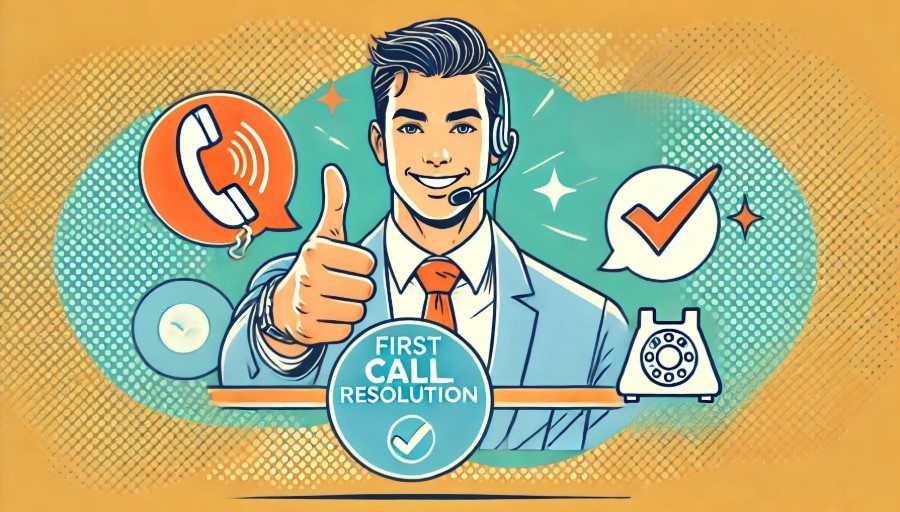First call resolution (FCR) is one of the most important customer-service metrics. Especially so for businesses handling a substantial number of customer-service inquiries. It’s a good indication of how efficiently a service team is providing support. It also serves as a predictor of customer satisfaction, brand reputation, and operational efficiency. It can ultimately affect a company’s bottom line.
If you aren’t tracking your FCR, you should be. In this article, we talk about what First Call Resolution is, why it’s important, and how to improve it.

What Is First Call Resolution?
First Call Resolution (FCR) is a measurement used by call centers and other service centers to determine what percentage of customer queries are resolved on the customer’s first interaction. This measurement is mostly applied to phone calls, but it can be calculated using any service channel or support experience. Of all call-center metrics, FCR is one of the most important, as it indicates overall call-center performance.
As applied to other contact channels – social media, chatbots, live chat, and other service channels – the term “first contact resolution” is used. This metric is important because it directly correlates with customer satisfaction. The quicker a support agent can provide a resolution, the happier the customer tends to be. Delayed resolution affects customer satisfaction. As a quick resolution becomes a hallmark of a business, brand loyalty also increases.
How to Calculate First Call Resolution
The First Call Resolution formula starts by tracking the total call volume your customer service team receives in a given time period. Depending on the business, you can also track texts, emails, social media messages, chats, and any other method your business uses to communicate with customers.
Next, keep track of how frequently problems get solved on the first attempt, as opposed to calls that require additional assistance or repeated calls. You can then calculate your business’ FCR score by dividing the second number by the first.
Here is an example of the FCR formula at work. Let’s assume you receive 1,000 calls from customers in any given month. If 200 of those calls are resolved without the need for any additional calls or support, then your FCR ratio is 200/1000, i.e., 20 percent. Depending on your contact center’s ability, these numbers could be higher or lower.
Improving First Call Resolution
The first step in improving first call resolution is identifying common issues that require multiple contacts throughout the resolution journey. As you examine your contacts, you’ll probably start to notice patterns or customer issues that require multiple contacts to resolve.
The next step is to uncover processes within your customer service that are causing these multiple contacts before a resolution can happen. For example, if multiple departments are involved in a common customer problem, consider consolidating that resolution process. When a customer is required to contact multiple people or departments, the likelihood of a quick resolution decreases.
Implementing Strategies to Improve FCR
Enhance Agent Training and Knowledge
When agents aren’t properly trained or lack product/service knowledge, FCR becomes extremely difficult. Such representatives may escalate many of their calls to superiors because they don’t know how to resolve the issue. Better customer service training and resources for support agents will increase FCR.
Streamline Contact-Handling Procedures
Try to reduce the number of steps needed to handle common repeat requests. If your current contact-handling procedures involve repetitive tasks, automate them whenever possible. Reduce the burden on your support team by creating templates they can follow for the most common customer issues.
Empower Agents to Make Decisions
After a while, customer service agents can become very knowledgeable about how to best help their customers. Empower them to be able to make decisions that will please customers without having to constantly get approval or follow antiquated guidelines that may not be changing with the needs of your business.
Implement Self-service Options
If possible, let customers help themselves through self-service options such as a portal, online knowledge base, FAQ page, or community discussion board. Knowledge-base articles are simple to create and post online, making them a popular option for most businesses. A customer’s first contact with a self-service option is often enough to resolve most issues. If they have more complex issues or can’t find a solution themselves, they can contact support.
Training Agents on First Call Resolution
Agent training is one of the most important factors to consider when trying to improve your First Call Resolution rates. A well-trained agent can navigate complex issues and make the customer feel valued. Train agents to have a deep knowledge and understanding of what your business offers. Only then can they share that knowledge with customers.
Don’t forget to teach your customer service agents effective communication, listening, problem-solving, and decision-making skills. These soft skills are the difference between a poor customer service representative and a great one. Some people are more naturally gifted in these areas, but everyone can develop these talents with effort and practice.
Promote a customer-first mindset within your company. Developing an empathetic approach to customers and having a positive mindset will make your FCR rating grow. Don’t forget to offer periodic training sessions to your support agents. Everyone can benefit from a reminder to focus on FCR goals.
Tools and Technologies to Improve First Call Resolution
FCR isn’t all about customer service agents. Leveraging technology is a great way to improve First Call Resolution.
Customer Relationship Management (CRM) Systems
If you aren’t using a CRM system, consider implementing one. This type of software makes it easy to keep track of customer interactions. You’ll be able to see service history, talk time, contact reason, and a history of email support, including any follow-up emails. It is much harder for customers to fall through the cracks when using a CRM system.
A CRM system can also track total resolved cases, agent performance, agent productivity, call colume, and average handle time. It will expose excessive wait times and provide quality monitoring. These essential metrics and insights can help raise FCR rates.
Knowledge Bases and Self-service Portals
Create a robust knowledge base and customer self-service portal so that customers can solve their problems without having to contact support. It may seem counterintuitive, but customers would rather solve their own problems than call in to support.
Call Analytics and Reporting Tools
Use call analytics and reporting tools to get a bigger picture of what’s going on within the business from a customer service perspective. Some tools will automatically calculate FCR and other measures of customer service success to make keeping track even easier.
Automatic Call Distributors and Intelligent Routing
Whether it’s calls, texts, chats, or other messages, routing customers to available agents is essential. Using automatic call distributors and intelligent call routing makes this a simple process and allows agents to engage customers in the shortest time possible. Include callback options in whatever system you use to increase the options available to customers.
Almost 90% of customers expect their issue to be resolved in a single call, which is why ‘First Call Resolution’ is one of the most critical metrics within the #ContactCenter.
Learn how automatic call distribution helps organizations make that happen: https://t.co/rK0JQTaAQ5
— Nextiva (@Nextiva) May 23, 2022
Best Practices for Achieving High FCR
Whatever your current FCR is, it can always be improved. Try some of these best practices and find out which ones work best for your business.
Set Clear Goals for FCR
In order to change and improve, you first need to measure. Find out what your FCR is currently and set a goal to improve it. A realistic goal for your business will depend on how complicated your product or service is. Be careful not to set unrealistic FCR expectations. A better approach may be to set a goal for improvement. For example, whatever your current FCR is, set a goal to improve by 5 percent. Clarify any conflicting priorities and conflicting performance goals.
Monitor and Measure FCR Regularly
Don’t take your eye off the ball when it comes to FCR. Monitor it regularly to ensure that more resolutions occur during that first contact. Don’t forget what a high FCR means: happier customers, better reviews, and a lower overall customer service cost, to name a few.
Collect Customer Feedback to Identify Areas for Improvement
Dissatisfied customers will always let you know where you fall short. Don’t shy away from asking for feedback, and don’t forget to act on it. Collect post-call surveys or conduct other methods of feedback collection. Making improvements to your customer service will contribute to an improvement in FCR.
Recognize and Reward Agents Who Consistently Achieve High FCR
An agent that can consistently achieve a high FCR is an asset to your business. Foster this positive achievement in all your agents by recognizing their achievements. Consider offering rewards or incentives to agents that achieve a high FCR. It could be something small like an extra break or a gift card. It could also be something more significant if measured over a longer time period.
First Call Resolution: Key to Customer Satisfaction
First call resolution is an important metric to track and improve because it directly correlates to a customer’s satisfaction. Happy customers are the lifeblood of a business. If you haven’t been tracking FCR, now’s the perfect time to start. Train your agents, leverage technology, and implement best practices for improving FCR. This will lead to better service, happier customers, and increased revenues.




